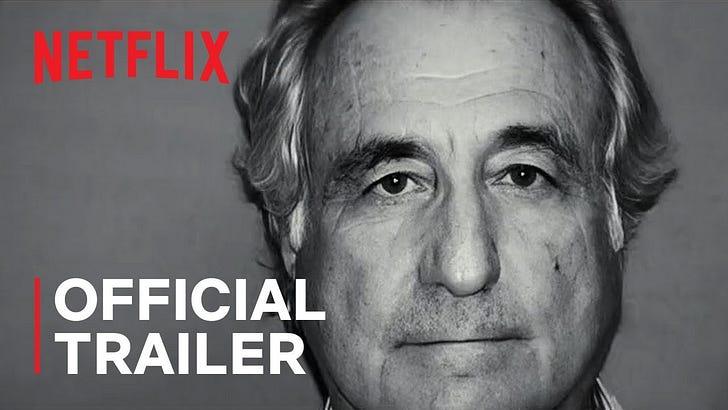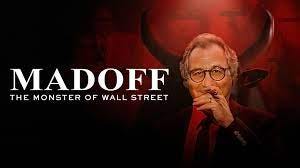Madoff: The Monster of Wall Street
The new Netflix documentary is a must see film for students of finance
As you know, I have been writing recently about some of the financial garbage that has washed up on shore in the wake of 2022’s financial correction, including Sam Bankman-Fried and FTX. The SBF/FTX scandal is an important story, but it pales in comparison to some of the other really big scandals on Wall Street, most notably Bernie Madoff’s massive Ponzi scheme uncovered in the wake of the 2008 global financial crisis.
The Madoff scandal is a story that I thought I understood, but it turns out there is more to it than I knew and the facts are even more troubling than I recalled. I am writing about this topic now not only because it is timely but also because I just finished binge-watching the excellent new Netflix documentary, Madoff: The Monster of Wall Street. I really hope you will all watch this four-part documentary in its entirety (see links to the trailer and review below). I promise you this will be time well spent.
But for the benefit of my younger readers, some of whom may not yet be familiar with Madoff, here is a quick overview:
Over several decades beginning in the early 1990s, Bernie Madoff—a major Wall Street figure and a former chairman of Nasdaq— took in almost $20 billion in cash from private investors, with much of his early fund raising centered in the wealthy Jewish community in Palm Beach, Florida, of which he was a part. He started small, but quickly gained quite a following after reporting to his investors consistently high and stable returns even during periods of market volatility. Madoff’s operations were conducted almost entirely in the shadows—he never registered with the SEC as an investment advisor, he never advertised and he worked hard to keep his activities out of the public eye. He was also very selective about whom he took on as clients—you needed good personal connections to get in on the action and if you ever asked too many questions or wanted to take too much money out you were quickly ‘fired’ as a client. Despite the secrecy, or perhaps because of it, Madoff’s reputation quickly spread by word of mouth and by 2008 he was managing a purported $70 billion (including accumulated investment gains) on behalf of private investors across the world, making him one of the largest private fund managers on Wall Street.
As out turns out, however, this $70 billion never really existed. Madoff had indeed taken in almost $20 billion of cash from private clients, over many years, but he never actually made any investments on their behalf. And the attractive investment returns he reported to his investors were entirely fictitious. Madoff issued fabricated account statements and used the cash on hand (including cash from new investors) to pay dividends and make occasional distributions to existing clients, as well as to fund his lavish personal lifestyle. This was a classic Ponzi scheme, which Madoff was able to keep going for as long as he did only because most clients chose not to take out much money in the way of distributions, given the consistently high rates of return reported on their account statements, returns which also attracted the large inflows of new money needed to fund the occasional large payouts.
Over the years, Madoff’s scheme survived a number of market corrections and large client withdrawals, occasionally with the help of a few big investors who may or may not have been complicit to some extent in the fraud. But even Madoff could not survive the cataclysmic events of 2008, which triggered massive amounts of investor redemptions across the world. Madoff’s customer cash account at JP Morgan, which had until then maintained an average balance of $3-6 billion, quickly fell to zero.
At this point the jig was effectively up and Madoff confessed to his crimes. He was turned into the FBI by his two sons, who worked in another part of the family business and were apparently not part of the Ponzi scheme. Madoff pleaded guilty to various fraud charges and was sentenced to 150 years in prison, where he died a decade or so later at the age of 82. While Madoff was in prison, one of his sons committed suicide, the other died of cancer, and Madoff’s widow (who had remained loyal to him for 70 years) was bankrupted and ejected from the family home(s).
Irving Picard, the aggressive liquidator appointed to clean up the mess, remarkably recovered close to $17 billion of cash for the benefit of Madoff’s victims, even after taking out $1 billion in fees for himself and his law firm. He did this in large part by clawing back from early investors the distribution amounts they had received in excess of their initial contributions, plus interest. This effectively bankrupted many of Madoff’s early, smaller investors to reimburse the later, larger ones—an approach which may have been legal and even equitable under the circumstances, but which caused untold hardship and seemed harsh to many.
Of the $17 billion recovered by Picard, about 40% ($7bn) came from Madoff’s single largest investor, a controversial individual who had bailed Madoff out on more than one occasion and who was found dead in his Florida pool ten months or so after the fraud was uncovered. Another large investor, who also acted as a ‘feeder’ for wealthy European investors (reportedly including some very dangerous people), committed suicide in his NY office. Facing potential criminal charges for its role in facilitating the fraud, JP Morgan settled out of court and paid $2 billion in penalties, without admitting its guilt. The SEC, which had failed spectacularly in all things Madoff related, was pilloried in Congress and eventually enacted (or at least announced) a number of reforms intended to prevent a replay in the future. Other than Madoff and several employees directly engaged in executing the fraud, no one else went to prison.
The Madoff scandal was a shocking and significant event in our recent financial history, and it is a story with which all finance students and practitioners should be familiar. It is also a riveting story of “trust, betrayal and pure evil” (to quote from the trailer), which makes for great television viewing. There is much to learn from the Madoff scandal, on which I may comment more in the future, but from my perspective the most important thing is for my younger readers simply to know the story in all its gruesome detail.
And so I encourage you all to watch the Netflix film if and when you can. You will want to watch all four episodes, each of which is better than the one before, and try not to get hung up on some of the gimmicky staging (using actors intermingled with photos of the real characters). So grab your popcorn and hunker down for the duration. I promise you this will be time well spent.
And recall this story the next time you are tempted to put money into crypto.
Links:
Madoff the Monster of Wall Street (trailer):
Madoff the Monster Review, WSJ (2023): https://www.wsj.com/articles/madoff-the-monster-of-wall-street-review-netflix-bernie-madoff-scandal-documentary-joe-berlinger-11672787022
Bernie Madoff Obituary, NYT (2021): https://www.nytimes.com/2021/04/14/business/bernie-madoff-dead.html
The Talented Mr. Madoff, NYT (2009): https://www.nytimes.com/2009/01/25/business/25bernie.html
Madoff Arrested, NYT (2008): https://www.nytimes.com/2008/12/12/business/12scheme.html
Markopolos Congressional Testimony (video):
Markopolos Congressional Testimony (transcript): https://www.sec.gov/news/studies/2009/oig-509/exhibit-0269.pdf
JPMorgan Settles Madoff Claims for $2 Billion (2014): https://archive.nytimes.com/dealbook.nytimes.com/2014/01/07/jpmorgan-settles-with-federal-authorities-in-madoff-case/
Madoff Investor Jeffrey Picower Found Dead in Pool (2014): https://www.nytimes.com/2009/10/26/business/26madoff.html
Press Release from Madoff Liquidator Irving Picard (2019): https://www.prnewswire.com/news-releases/press-release-from-the-offices-of-irving-h-picard-sipa-trustee-for-the-liquidation-of-bernard-l-madoff-investment-securities-llc-blmis-and-josephine-wang-president-and-chief-executive-officer-of-the-securities-investor-prot-300976935.html
SEC Statement re Post-Madoff Reforms (2019): https://www.sec.gov/spotlight/secpostmadoffreforms.htm



